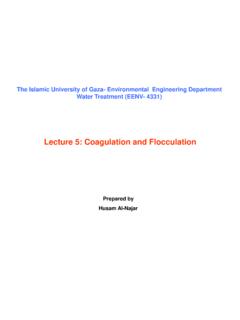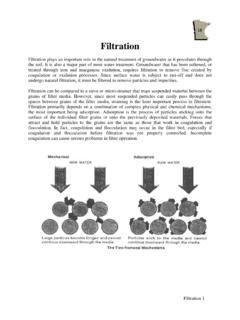Transcription of -WATER TREATMENT PLANT- - QUT
1 Activity Kit 4 water TREATMENT Plant 1 - water TREATMENT PLANT- OBJECTIVES: Learn where our drinking water comes from and how it gets to our household tap. What makes water unclean and what harmful contaminants it can contain? Understand the extreme complexity of providing water to society. Discover the water cycle. Recognise the need to conserve and protect our environment and water sources. Discover how water quality is tested and the guidelines that exist in controlling the quality of water .
2 Australian Drinking water Guidelines (ADWG). ADWG 2002 (Australian Drinking water Guidelines) what it is and how to test for it? To explore and identify the different types of processes in a water TREATMENT Plant (WTP). Appreciate the important aspects of a WTP and complete an activity that shows some processes of a WTP. Understand the role of technology in a WTP and its impact on society and the environment. SAFETY NOTES: Supervision is recommended as the activity uses: Aluminium Sulfate Solution Use only in ventilated areas Do not drink any samples WORDS TO KNOW: Aluminium Sulfate, Al2(SO4)3 Coagulation Flocculation filtration Clarifier Sedimentary Tank Disinfection Sludge Thickening Reservoir Scour Flash Mixing Jar Testing Turbidity PREPARATION TIME: LESSON TIME.
3 Activity Kit 4 water TREATMENT Plant 2 RAINWATER TO TAP water - THE PROCESS The process from rainwater to tap water is more complex than you might imagine. The water that comes out of your tap has been through various processes that clean and change its original properties, physically and chemically. Do you know what the processes are? The aim of this Engineering Kit is to introduce you to a number of water TREATMENT Plant (WTP) processes that are commonly used in getting clean potable water to your household.
4 Civil Engineers design, monitor and maintain water TREATMENT plants and water supplies. Civil engineers are vital in the TREATMENT and delivery of water to your household. water supply is the water that comes into your property from the water mains via a service pipe and through the water meter into your home. water is a limited resource. Less than one per cent of the earth's water is fresh and can be utilised for human consumption. The amount of this water will never increase as the water cycle is a closed system.
5 Australia is the driest inhabited continent on earth. This seems hard to imagine when we have always been able to turn on a tap and out comes as much water as we need. Have you ever thought what would happen if you turned on the tap and no water was available or the water was unfit to drink? What would you do? How would you survive? Where would you get water from? DRINKING water Drinking water is water that is safe for humans to drink and to use for domestic purposes, such as cooking, washing up, bathing and showering.
6 The Australian Drinking water Guidelines (ADWG) provides the Australian community and the water supply industry with guidance on what constitutes good quality drinking water , it is concerned with the safety of water from a health point of view and with its aesthetic quality. According to the Australian Drinking water Guidelines: Ideally, drinking water should be clear, colourless, and well aerated, with no unpalatable taste or odour, and it should contain no suspended matter, harmful chemical substances, or pathogenic microorganisms.
7 Drinking water must not contain chemicals, organic substances or organisms that may be harmful to human health. Drinking water should also be at a reasonable temperature and be free of unappealing odours, tastes and colour. The ADWG also define drinking water as water ..which, on the current state of knowledge, is safe to drink over a lifetime: that is, it constitutes no significant risk to health . When most Australians turn on the tap, they expect a continuous supply of drinking water that meets these guidelines water that is safe and pleasant to drink.
8 Do you think that water from the tap is safe to drink? Do you observe your tap water s aesthetic quality that is, its taste, colour and odour or do you just drink it regardless? Activity Kit 4 water TREATMENT Plant 3 PART ONE: MATERIALS: 4 Students Booklets 1 Master Booklet Activity Worksheet Part One Bottles (Samples 1-3) of water RAIN TO YOUR 1. There are 3 bottles of water to assess; the object of this task is to use one of the physical properties of water , colour, to determine which one is suitable to drink.
9 2. Using the sheet provided mark selections. 3. Identify the waters and reasons why you chose them? PART TWO: 1. Divide the class into 4 groups and allocate them materials. MATERIALS: Group 1-4 Coagulation and Flocculation and filtration Activity Instruction Booklet Activity Worksheet Part Two Part A- Coagulation and Flocculation 4 500ml Plastic Beakers 4 Plastic stirring paddles 4 120ml Plastic Beaker 3 25ml plastic beakers 3 1ml Pipettes 2L Jug Timer- stop watch White Paper Alum Solution 10mg/L pH Strip water 2L Soil 1gram Part B- filtration 1 120ml Plastic Beaker Plastic Funnel Wet sand Media Special Coal Small Gravel Stand & Holder for Funnel Tweezers Filter Paper Pump Laboratory
10 Filter White Paper 2. Each group will now start the coagulation and flocculation process as outlined in the instruction sheets. 3. Part A involves a Jar Test and sedimentation of the suspended solids. 4. Part B involves investigating filtration systems in the water TREATMENT process. Activity Kit 4 water TREATMENT Plant 4 water TREATMENT PROCESS A water TREATMENT Plant aims to ensure that water is: Safe for human consumption Pleasant to consumers Provided at a reasonable cost water TREATMENT plants have many processes and steps before a household turns on their tap and receives water .












